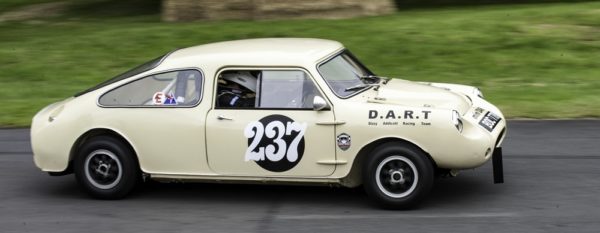
Seen at the Château Impney Hill Climb in 2016, driven by Stefan Wray, the Mini DART is perhaps the most important of all the Mini derivatives – the Mini Marcos, Mini Jem and Kingfisher Sprint were all born from it.
In 1963 Desmond ‘Dizzy’ Addicott, a fighter pilot and in his spare time a Mini racer, decided to modify and streamline a Mini for racing. He christened the project DART (Dizzy Addicott Racing Team).
He was helped by Paul Emery, a racing car builder in West London. They bought a damaged Morris Mini van and cut and shut it. Addicott wanted to use lightweight materials, but the body was in the end made from steel. They fitted a 1,071cc Cooper engine and tested the car in a wind tunnel, where it was found to be stable and aerodynamically effective.
The DART was shown at the Racing Car Show in January 1964 on Paul Emery’s stand. The car was well received and Jem Marsh of Marcos helped to make a fibreglass mould for production, using the steel body as the model.
Bodies were produced, but Addicott was unhappy with their quality, and parted company with Marsh. Very soon after, Marsh developed the project into his famous Mini Marcos. Addicott had lost interest in his own project and sold it to Jeremy Delmar-Morgan. It became the Mini Jem in 1966.
The steel-bodied DART prototype disappeared, but years later turned up in a Leicester scrapyard in very bad condition. After passing through several hands it ended up with the present owner Stefan Wray, who restored it beautifully, finishing it in 2008. Sadly, Dizzy Addicott died three years earlier in 2005 at the age of 83.
Photo and research by Peter McFadyen. See his website: http://petermcfadyen.co.uk







Leave a Comment